Page 1 of 1
Knossos
Posted: Wed Oct 24, 2007 9:08 am
by Minimalist

Bright and early the next morning, after a rush hour bus ride through the city of Irakleion we arrived at Crete’s most famous landmark...6 Euros is about 10 bucks, now, as the dollar is basically worth a fart in a hurricane at this point.

Long view of the site. What Sir Arthur Evans found were mainly the low walls and everything higher than that were his own reconstructions. Unlike what had been done at Ephesus Sir Arthur used modern concrete to reconstruct what the buildings would have looked like. This has apparently fallen afoul of modern archaeological theory but it must be remembered that Evans was working in the 1920's when a lot of these rules did not exist. In any case, keep in mind that you are seeing is Evans’ opinion of how things would have looked....although he did have the original frescos to give him an idea. The frescoes have been removed to museums for preservation but several were replicated and are included in the photo essay below. Enjoy, mes amis.

A sample of the low walls. Because the palace was built in at least three storeys, some of the rooms underneath were better preserved than the upper floors. Storerooms, including one that suffered a terrible fire, were visible below.

A sample of a restored Minoan walkway.

From the entry plaza, shooting down to another section which Evans restored. Evans did make an effort to re-cycle some of the stone but the modern concrete is clearly visible. Part of the reason for the sprawling, almost haphazard, building plan is that a great many of the rooms were lit by sky lights and it was necessary to arrange things to make the maximum advantage of the sun. It’s pretty easy to see how the idea of the labyrinth came about. To primitive Greeks in the middle of the second millenium bringing them to Knossos would have been the modern equivalent of dropping a New Guinea tribesman in Times Square.

If I didn’t mention how spectacular the view was this picture will give some idea. It’s Good To Be The King.
Posted: Wed Oct 24, 2007 9:28 am
by Minimalist
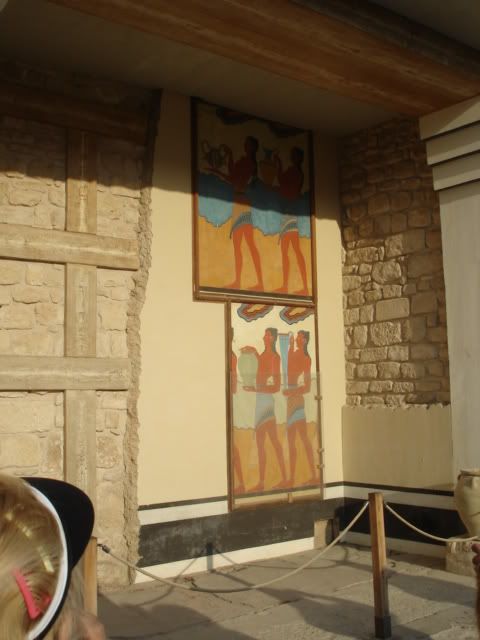
Replicas of frescoes in the Irakleion Museum. The whole building was redone by Evans, of course, and our guide spent some time explaining the frescoes.
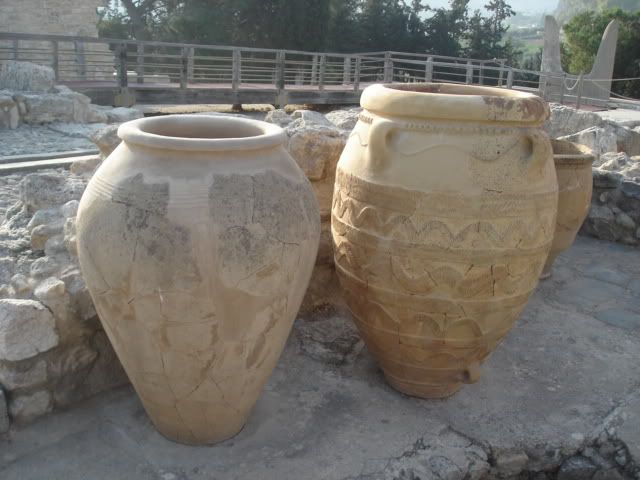
These storage jars were about 4 feet high and not quite the classic amphora shape which later evolved. They were found in a warehouse area of the palace, reassembled and put on display. Unlike amphora these would have been heavy as all hell and were probably not picked up all that often. The wide mouths would have allowed people to reach down and scoop out the contents into smaller containers. They envision rooms full of these vessels for the various products which supported the palace.
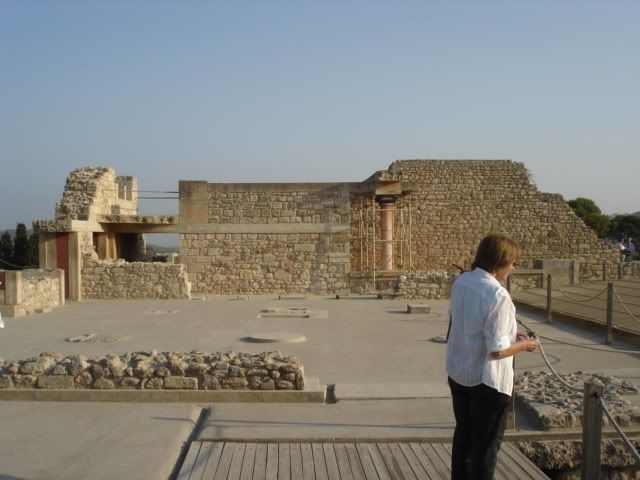
More of Evans’ restoration work. Note the concrete beam in the center of the wall. Crete, still forested now was much more heavily forested in antiquity. It is speculated that wooden beams might have served the purpose of Evans’ concrete as opposed to just having a wall of stones piled up. Minoan engineering was quite advanced. They had running water, sewage, solar lighting and forced air heat in the Middle Bronze Age. Such did not generally come into usage again until the Romans.
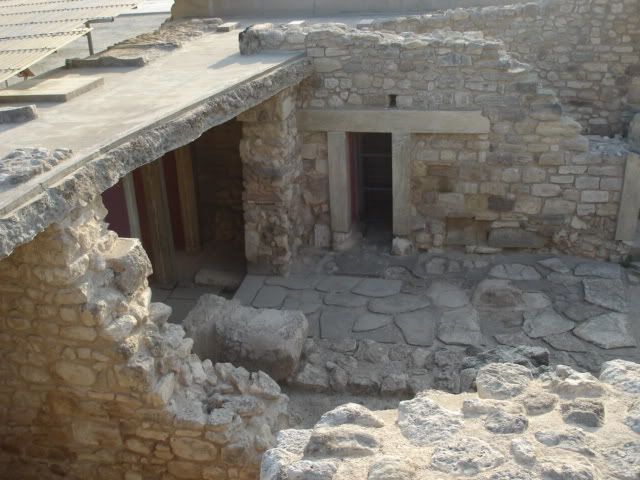
A look down into the lower levels.
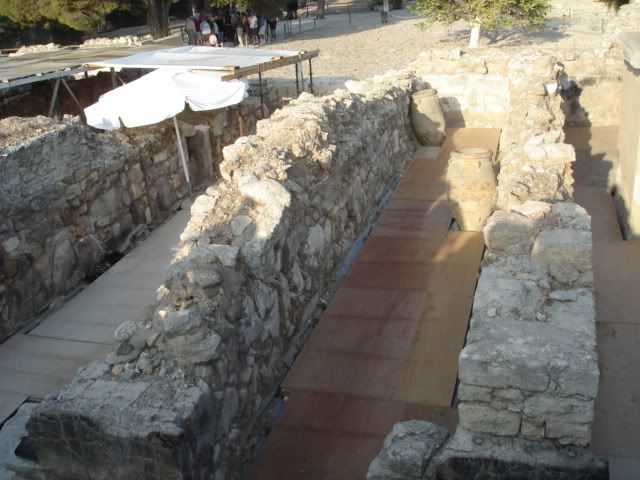
A storage area, the roof collapsed in an earthquake, note the blackened edges of the stones at the near end. Speculation is that oil stored in the jars was set alight by oil lamps. Damage would have been extensive but limited to a relatively small area judging by the blackened stones they have found.
Posted: Wed Oct 24, 2007 9:49 am
by Minimalist
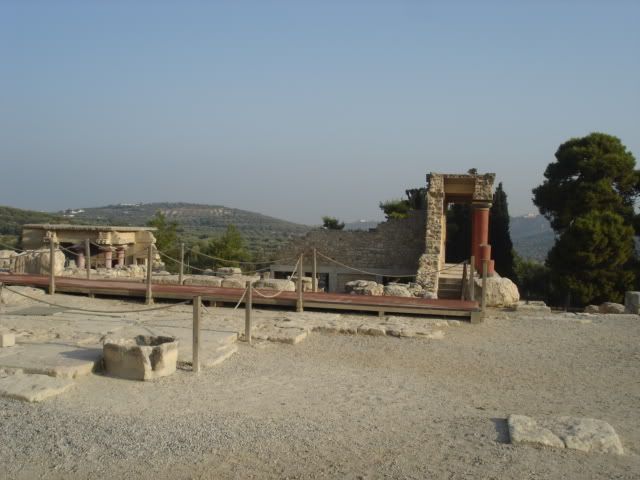
Another countryside view with a restored portion in the view. Curiously, Minoan columns had the unique design feature of being wider on top than on the bottom. No one has any real idea of the reason for this. As with all archaeology, when they don’t understand something they attribute it to ‘ritual’ styling but no one can hazard a guess what the ‘ritual’ might have been.
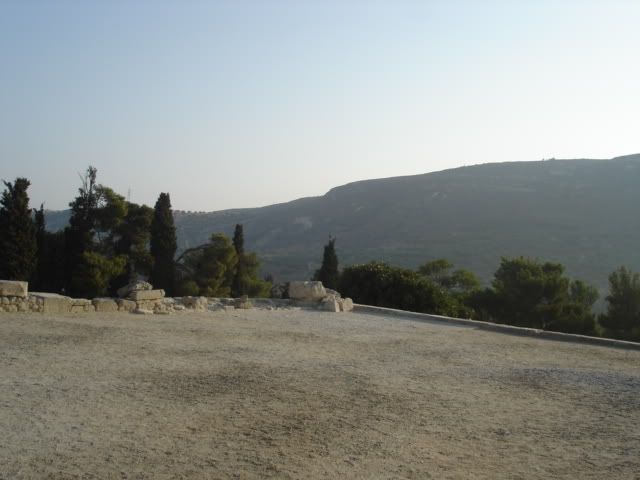
Speculation is that this was a parade ground for the Royal Guards. Crete was maintained by her navy and standing armies would have been rare and expensive. Still, one would expect the king to have kept his version of the Praetorian Guards around just to awe visitors!
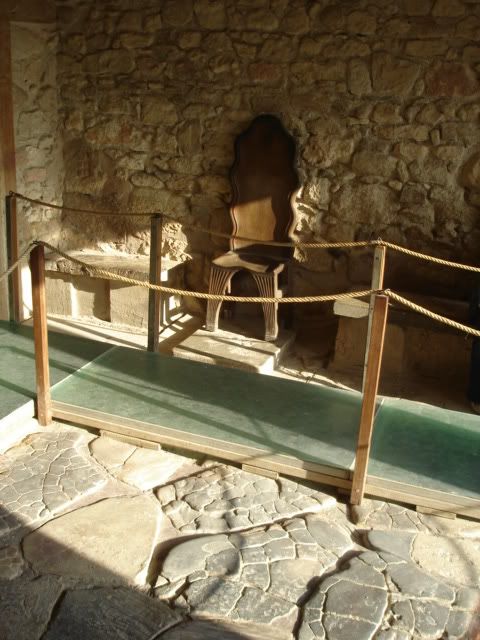
This was most likely not a “throne room” but some sort of antechamber. The original flooring is still visible although parts are covered with a wooden walkway to allow access to the internal rooms.
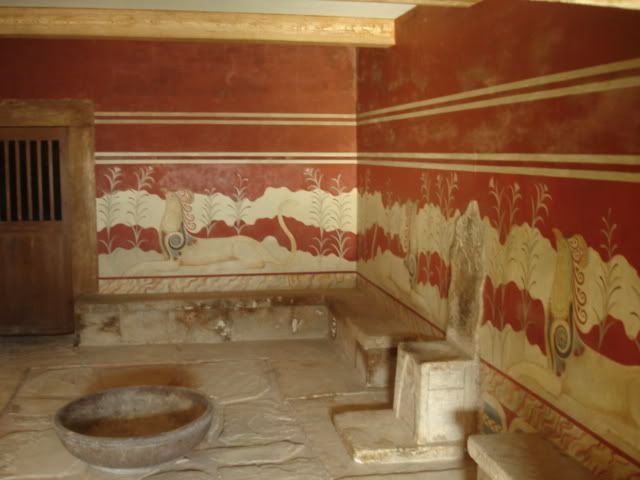
Now this could have been the throne room. As you’ll see later from a picture I picked up off the web it is located in the center of the complex, which is always a good bet for an important spot.
Again, the frescoes are copies but the originals do exist and are safely tucked away in museums.
Standing in there was a bit magical although I had to back up to get the picture. It is not terribly big.
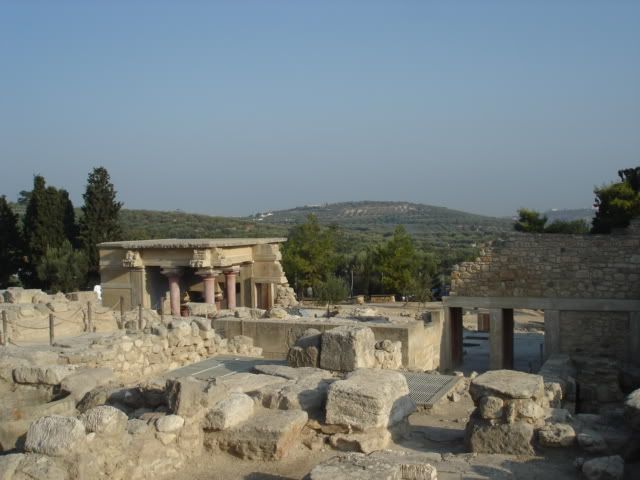
It is speculated that the ancient town would have spread to these hills and had a population of perhaps 60,000. Small today but massive for the MBA.
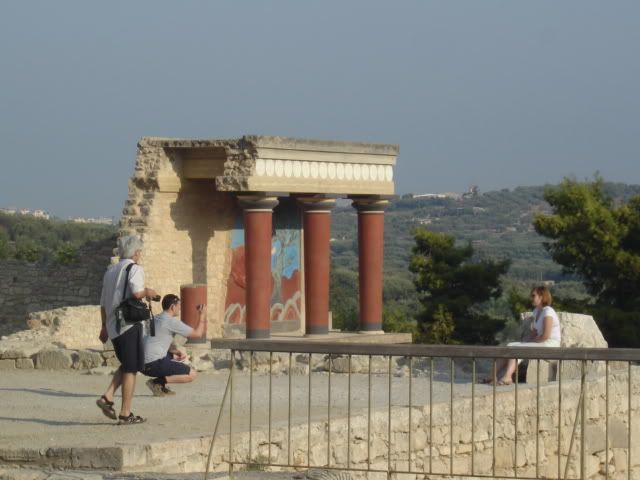
We worked our way around for a close up shot of this building. The fresco made use of the bull theme, which would be more apparent if I hadn’t got the column in the center of my shot!
Posted: Wed Oct 24, 2007 10:09 am
by Minimalist
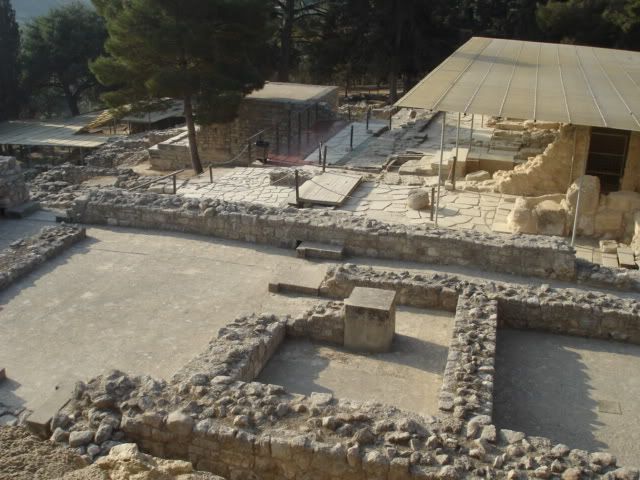
This shot gives some idea of the vertical stacking of the palace. The lower level is dug into the hillside. Construction was from local limestone for the most part. Again, it is impossible to overstate the sprawling nature of the place.
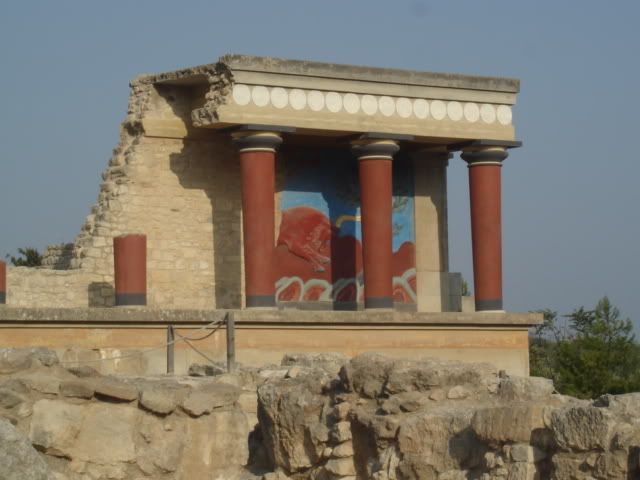
Realizing my mistake with the earlier shot, (thank heaven for video review on digital cameras!) I moved to the right, leaned over a wall and got a better shot of the bull fresco.
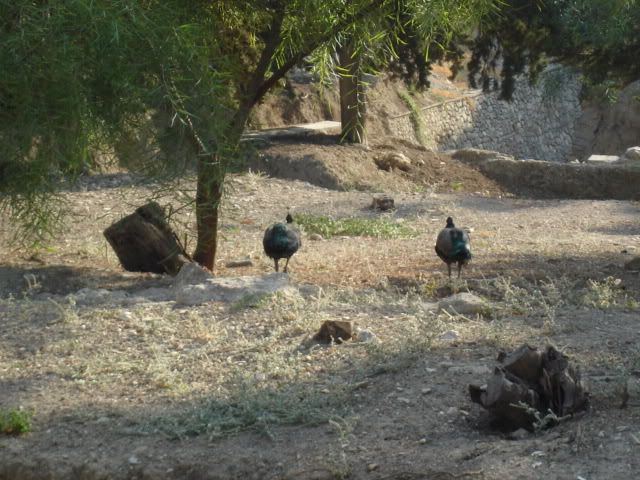
There are pheasants on the grounds....everyone was trying to get them to open their feathers but they said “screw you....damn tourists” and turned away.

Someone with far too much time on his hands drew this diagram of the palace. As you can see the suspected ‘throne room’ is centrally located, right off the ‘parade ground.’ The palace covered six acres and consisted of 1,300 rooms. Many cannot be shown on the sketch because they are located below the upper floors.
This was the last achaeologically significant site we visited. Santorini, later this day, was primarly a tourist site as the ruined city of Akrotiri was closed. The following day was Patmos and then Mykonos. Patmos entailed another climb down to a cave and another climb up to a monastery. By the time we got to Mykonos we were so beat that we decided to stay on the ship and have a swim. Nonetheless, I have some touristy photos from those places and I’ll get them up ASAP now that I have discovered Photobucket’s “Bulk Upload” feature.
Posted: Wed Oct 24, 2007 10:47 am
by Digit
Evans deliberately left the concrete on display Min so that the restoration was obvious. He used so much concrete as the alternative was a rock pile in some cases and to hep prevent further damage from quakes.
Posted: Wed Oct 24, 2007 2:02 pm
by Minimalist
Yeah, Dig, it seems to be a modern philosophical dispute between the way Evans did things and modern restorative techniques. I'm not going to give him any shit over it. He was what? 30 years removed from Heinrich Schliemann? Things were different in the 1920's.
Posted: Mon May 26, 2008 7:41 am
by Pippin
Hi
Im told that Heinrich Schliemann actualy wanted to excavate the site, but found out that the owner tryed to cheet him, there were not as many trees on the area as the owner claimed. The old grocer didnt like to be cheated, so he went somewhere else to ruin stuff.
Kim
Posted: Mon May 26, 2008 8:18 am
by Minimalist
so he went somewhere else to ruin stuff.
Hey, Pip. Nice way to phrase it!





















